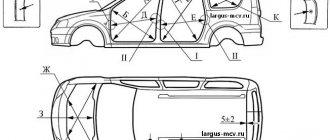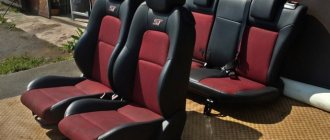On a regular Lada Largus van, the body dimensions are selected so that Euro pallets can be transported. We are talking not only about the space between the pillars, which are spaced 108 cm apart, but also about the distance between the wheel arches. It is 96 cm, and one pallet takes 80. The distance from the rear doors to the partition generally approaches two meters! A little more and it would have been possible to fit a couple of Euro pallets. Here we will look at how to remove the partition between the body and the cabin, and at the same time remove the inner bottom of the body. The first is needed for transporting long cargo, the second is also used for some reason.
We study the fastening of partitions and floors. Everything is shown in one video.
Linear dimensions of the cargo compartment of the Lada Largus van
All the sizes you need to know are shown in the photo. The van doors here are fixed at an angle of 90 degrees, but they can be opened all the way to 180. They are fixed in either of the two positions.
Luggage compartment of a Largus van
Let's list everything that is marked in the figure:
- The greatest height of the opening is 92 cm;
- Opening width – 108 cm;
- The distance “from arch to arch” is 96 cm;
- The distance from the edge of the threshold to the partition is 194 cm.
If you lay sheets diagonally, the width of the sheet should be less than 130 cm.
When the partition remains in place, the internal volume of the Lada Largus van is 2540 liters. Load capacity is 725 kg. These figures are indicated by AvtoVAZ.
In fact, the maximum lifting capacity exceeds a ton. It all depends on the road conditions and driving style.
About the car
With impressive cargo compartment dimensions, the Lada-Largus van is a practical domestic vehicle based on the B0 platform. By its nature, this is a Renault Logan Van, released in 2006, on which specialists simply changed the emblem and performed some modifications. The Lada-Largus is perceived as a workhorse, which will appeal to both avid lovers of trips to the countryside and entrepreneurs who specialize in small cargo transportation.
Unfasten the partition or part of it
The partition separating the body and the cabin consists of two halves. They can be removed separately. Both parts are screwed to the body with screws designed for a 13mm key size. Of course, you need a socket wrench.
Screws 1 were hidden under the casing
The four screws on the left and right are located on the cab side. And to unscrew them, remove the casing.
All actions with cladding
The left part of the septum is removed after the right. To remove only the left half, first remove both, and then mount the right sash back. Based on this, immediately decide where you will remove the trim - only on the right or on both sides.
The volume of the body on the Lada Largus van cannot be greatly increased, even if the partition is completely removed. But without the partition, by removing the seat, it will be possible to transport loads 3 meters long.
So, let's start dismantling the trim: you need to remove the seat belt (key “17”), and then unscrew one self-tapping screw. A Torx T20 wrench is suitable for the self-tapping screw.
Asceticism
The only obvious drawback of the Lada-Largus is its deliberate asceticism. The interior of the car has not changed at all since the creation of the first generation Renault Logan. This model contains only the bare minimum. But many car enthusiasts today want to see some additional frills in their cars, such as heated seats and mirrors, modern multimedia, and electronic assistants. The impressive dimensions of the Lada-Largus van, heated front seats, a single-din radio, an ABS system and rear parking sensors are all that are included as standard. The car is equipped with only two airbags and manual air conditioning.
Many cars are created with the aim of setting speed records and most of them captivate with their stylish and original design. The Lada-Largus van, with a body size that allows it to transport large items, was invented specifically for work and family. The car will be able to drive where sports cars with low clearance cannot move. At the same time, drivers will look at the Lada-Largus with real love, because only a working car is considered truly beautiful.
On a regular Lada Largus van, the body dimensions are selected so that Euro pallets can be transported. We are talking not only about the space between the pillars, which are spaced 108 cm apart, but also about the distance between the wheel arches. It is 96 cm, and one pallet takes 80. The distance from the rear doors to the partition generally approaches two meters! A little more and it would have been possible to fit a couple of Euro pallets. Here we will look at how to remove the partition between the body and the cabin, and at the same time remove the inner bottom of the body. The first is needed for transporting long cargo, the second is also used for some reason.
We study the fastening of partitions and floors. Everything is shown in one video.
Increasing the volume of the cargo compartment (removing the excess part on the floor)
The cargo compartment volume of the Lada Largus van can be increased. To do this, remove the floor covering.
There are two types of fasteners here
We will need special Torx keys, without which the screws cannot be unscrewed: Torx T30 and T40.
Study the picture carefully:
- T40 caps (2) are located at the corners, as well as on the line between the arches;
- The remaining screws (1) are designed for Torx T30 keys.
Removing the trim will be easy. And when you install it, make rubber gaskets. They are fixed to the ends of the frame so that the casing does not rust.
The removable floor (cladding) consists of two halves - left and right. First, according to tradition, the right one is removed.
Why did it happen so?
Perhaps the automatic requests do not belong to you, but to another user accessing the network from the same IP address as you. You need to enter the characters into the form once, after which we will remember you and be able to distinguish you from other users exiting from this IP. In this case, the page with the captcha will not bother you for quite a long time.
You may have add-ons installed in your browser that can make automatic search requests. In this case, we recommend that you disable them.
It is also possible that your computer is infected with a virus program that is using it to collect information. Maybe you should check your system for viruses.
If you have any problems or would like our support team, please use the feedback form.
The Lada-Largus van gained great popularity back in 2012, when the car first entered the domestic market, literally immediately ranking with such well-known car brands as Citroen Berlingo, Renault Kangoo and VW Caddy. But it is worth noting that Lada-Largus is in a completely different price segment. The car developers tried to make the model as affordable as possible, without reducing the quality of the external and internal finishing, while maintaining a high degree of structural strength and the large size of the cargo compartment of the Lada-Largus van.
Lada Largus technical specifications
Many potential car buyers are interested in the main technical characteristics of the Lada Largus. The car is a clone of the Dacia Logan MCV car of the Renault-Nissan alliance, which has gained some popularity in Europe, redesigned for domestic operating conditions. The Lada Largus model has similar technical characteristics. The car body type belongs to the category of high-capacity station wagons, and the dimensions of the Lada Largus allow the car to be classified both as spacious family cars and ultra-compact commercial vans.
Return to contents
Main body dimensions
The dimensions of the Lada Largus car differ little from those of its competitors, such as Fiat Doblo, Renault Kangoo, Peugeot Partner, Citroen Berlingo, Skoda Roomster, Volkswagen Caddy, Ford Connect Transit. The overall dimensions (body length/width/height) of the Peugeot Partner are 4380/1810/1800 mm, and the body dimensions of the Lada Largus are approximately the same.
Main dimensions of Lada Largus:
- length - 4470 mm;
- width - 1750 mm;
- height (including the dimensions of the roof rails) - 1670 mm;
- car base - 2900 mm;
- front track - 1469 mm;
- rear track - 1466 mm;
- front overhang - 795 mm;
- rear overhang - 770 mm;
- ground clearance under the lowest point of the engine - 145 mm;
- turning radius - 5.62 m.
The Lada Largus body has a hinged rear door. This ensures easy access to the luggage compartment, even in limited parking spaces. The left rear door leaf is noticeably wider than the right one, and the design of the car allows only it to be opened when loading and unloading.
Consumers care whether the Largus body is galvanized. It is known that all steel panels of the machine are double-sided galvanized.
Return to contents
Station wagon engine
The car comes with an 8-valve or 16-valve 4-cylinder fuel-injected engine with multiport fuel injection. The volume of these engines is 1598 cm3; cylinder diameter - 79.5 mm; piston stroke - 80.5 mm; compression ratio - 9.8. The 8-valve engine produces 90 horsepower and a torque of 128 N∙m. The maximum speed of Largus, equipped with such an engine, is 158 km/h, and acceleration to 100 km occurs in 13.4 s. The 16-valve engine is slightly more powerful, it produces 105 horsepower and a maximum torque of 148 N∙m. In this version, the maximum speed is 165 km/h, acceleration to 100 km is 11.8 s.
Lada Largus engines consume gasoline with an octane rating of 95. The car complies with Euro 4 standards. Lada Largus fuel consumption per 100 km in the combined cycle for a 5-seater version and a 16-valve engine is 11.5 liters, and on the highway - 7.6 liters per 100 km.
Ease of use
The practicality of the car is perfectly combined with a high level of comfort. The Lada-Largus van has a modern air conditioner and audio system, heated front seats, central locking, electric windows and other useful options that are a significant contribution to the profitability of the business. This is explained by the fact that driver comfort affects the success of transportation.
In addition to the above advantages, Lada-Largus has the following options:
- Power steering.
- The glove box is large.
- Pockets in the front doors for storing small items.
- The center console is ergonomic.
- A lighting point is integrated into the luggage compartment.
The car has high cross-country ability: ground clearance without load is 18.1 cm, with full load - 14.5 cm. The gear ratios in the gearbox are selected specifically for the cargo model.
Control dimensions of Lada Largus body geometry / Lada Largus
Dimensions of openings and clearances of mating parts of the LARGUS body
| A | B | IN | G | D | E | AND | 3 |
| 1380 ± 5 | 930 ± 4 | 1280 ± 5 | 1155 ± 15 | 925 ± 5 | 975 ± 5 | 1110 ± 5 | 610 ± 3 |
| AND | TO | L | M | N | ABOUT | P | |
| 795 ± 3 | 735 ± 3 | 1530 ± 5 | 800 ± 5 | 1380 ± 4 | 1030 ± 3 | 1140 ± 3 |
Mounting points for suspensions on the body
1 — front subframe mounting points; 2 — mounting points for the shock absorber strut; 3—rear subframe mounting points; 4 — guide holes of the front spar; 5 — front guides of the rear spar; 6 — guide holes for mounting the rear suspension; 7 — rear suspension mounting holes; 8 - holes for mounting the rear shock absorber; 9 — rear guide holes of the rear spar.
Scheme for measuring interaxial dimensions
Main disadvantages
Naturally, it’s difficult to talk about the shortcomings objectively, since everyone has different requirements, but it’s worth highlighting the main points that users don’t like the most:
- good sound insulation only in expensive versions;
- The seat heating control unit is inconveniently located;
- it is inconvenient to control the climate system;
- not very convenient control of the multimedia system;
- no front handles on the ceiling;
- The heating of the windshield does not cover the edges (the wipers do not cover them either).
dimensions and dimensions in centimeters, length, width
LADA Largus has long won the sympathy of Russian car enthusiasts. Drivers often pay attention to the large trunk volume of the Lada Largus, which is considered the main advantage of this car. Domestic cars also cope well with another task - providing inexpensive and comfortable travel on modern roads. These two aspects and the ability to accommodate a large number of passengers allowed the car, produced at the Russian AvtoVAZ, to become a popular model in the CIS countries.
The dimensions of the Largus trunk depend on the body variation, it can be:
Cross
The smallest trunk size is in the Largus minivan, designed for 7 seats. The Largus Cross trunk reaches a volume of 200 liters. The manufacturer helped car owners by allowing them to increase the volume of the luggage compartment in liters to 1600–1800, for which two rows of seats should be removed.
The seven-seater version (minivan) has the most “modest” luggage compartment. But the manufacturer met his loyal customer halfway and endowed this modification with a simple secret: it is also possible to increase the luggage space to the same 1600–1800 liters by performing an identical operation to dismantle the stern seats. To do this, you will need to remove two planting rows.
Of course, neither a station wagon nor a minivan are designed to transport large loads, but if necessary, they will cope with this task perfectly.
Technical characteristics of Largus van. Lada Largus van body length
Dimensions of the Lada Largus 2018 van
Dimensions of the Lada Largus van
Russian sales of Lada Largus began in July 2012. The car is available in 7- and 5-seater versions, as well as in a van body.
The car has the following technical characteristics: 8 and 16 valve petrol engine with a volume of 1.6 liters and a power of 87 hp. and 106 hp
The Lada Largus 2022 van has dimensions: 4470 mm in length, 1750 mm in width and 1650 mm in height. The volume of the luggage compartment is 2540 liters.
New video review and test drive of the van:
The station wagon consumes only about 8.1 liters per 100 km in the combined cycle
Tire sizes are 185/70R14, 185/65R15.
See vehicle specifications and prices here.
Technical characteristics of Largus van / MirAvto Lada
Technical characteristics of the Lada Largus station wagon in numbers. For ease of loading, the rear door leaves are fixed in 3 positions 40, 90 and 180 degrees. To properly secure the load, there are 6 mounting points, allowing you to secure even small items. The Lada Largus is equipped with the well-known Renault 1.6 16 valve engines with a power of 102 hp. and 8 valve with a power of 87 hp, only 5 manual transmissions are available. The van's load capacity is 800 kg and the trunk volume is 2540 liters. In the crash test, Largus scored 3 stars out of 5.
"Insides" of the car
The Lada-Largus van is equipped with the same gasoline engines as the station wagon of the same name - these are in-line fours with a displacement of 1.6 liters:
- 8-valve engine that is capable of developing 87 hp. With. at 5100 rpm.
- 16-valve engine with a potential of 106 hp. With. at 5800 rpm.
As standard, the car is equipped with a 5-speed manual transmission and a front-wheel drive transmission. From 0 to 100 km/h the Lada-Largus van picks up speed in 14-15.4 seconds to 158-165 km/h. In the combined cycle, the car “eats” 7.9-8.2 liters of fuel for every hundred kilometers.
The van is built on the front-wheel drive B0 platform. The actual size of the body of the Lada-Largus van and the dimensions of the entire structure make the car practical and at the same time visually compact.
Are there any competitors?
Due to its body layout, the Lada Largus does not have a large number of its “opponents,” especially in the market spaces of the CIS countries. This can be partly explained by moderate demand. If we again tend to limit ourselves only to post-Soviet market areas, then we are unlikely to find a worthy competitor to this station wagon in terms of carrying capacity. Impressive figures can serve as a simple confirmation of this:
- the van is able to overcome a weight of 800 kg;
- the station wagon can handle a 650-kilogram load, the volume in liters allows this.
Competitors are only able to get closer to these indicators, because their load capacity is at the level of 450-600 kg. The list of dimensional characteristics of the Largus trunk may bring a little disappointment, because in this discipline the station wagon is not a leader, but it is not “tagging along” in the “tail of the tournament bracket”.
Detailed information regarding dimensions is most clearly reflected in the following table:
As you can see, two positive aspects speak in favor of the universal “Russian woman”:
- enviable convenience when loading luggage, especially large ones, which is facilitated by the door opening limit (reaches 180 degrees with the doors fully turned out); Not a single universal model can boast of this feature;
- reasonable cost of the car, which is especially noticeable in comparison with famous competitors.
Important! Against the background of the entire set of indicators characterizing the versatility of the LADA Largus, it can be unequivocally stated that the domestic model, although in some minor disciplines loses to its rivals, in general terms, against their background it looks very decent and advantageous. Here, few will argue with the functionality of the “Russian woman”











